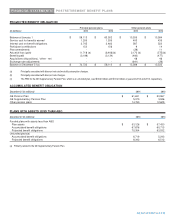GE 2014 Annual Report Download - page 185
Download and view the complete annual report
Please find page 185 of the 2014 GE annual report below. You can navigate through the pages in the report by either clicking on the pages listed below, or by using the keyword search tool below to find specific information within the annual report.
GE 2014 FORM 10-K 165
FINANCIAL STATEMENTS ACQUISITIONS & INTANGIBLE ASSETS
GOODWILL
CHANGES IN GOODWILL BALANCES
2014 2013
Dispositions, Dispositions,
currency currency
Balance at
exchange Balance at Balance at
exchange Balance at
(In millions) January 1
Acquisitions
and othe
r
December 31 January 1
Acquisitions and othe
r
December 31
Power & Water $ 8,822 $ 21 $ (89) $ 8,754 $ 8,821 $ - $ 1 $ 8,822
Oil & Gas 10,516 276 (220) 10,572 8,365 2,217 (66) 10,516
Energy Management 4,748 - (178) 4,570 4,610 7 131 4,748
Aviation 9,103 - (151) 8,952 5,975 3,043 85 9,103
Healthcare 16,643 1,004 (115) 17,532 16,762 45 (164) 16,643
Transportation 1,012 2 (127) 887 999 - 13 1,012
Appliances & Lighting 606 - (380) 226 611 - (5) 606
GE Capital 26,195 - (1,169) 25,026 26,971 17 (793) 26,195
Corporate 3 31 - 34 - 4 (1) 3
Total $ 77,648 $ 1,334 $ (2,429) $ 76,553 $ 73,114 $ 5,333 $ (799) $ 77,648
Goodwill balances decreased by $(1,095) million in 2014, primarily as a result of currency exchange effects of a stronger U.S.
dollar, the reclassification of goodwill associated with Appliances and Budapest Bank to assets of businesses held for sale,
and the sale of GEMB-Nordic and other dispositions, partially offset by acquisitions at Healthcare and Oil & Gas.
Goodwill balances increased $4,534 million in 2013, primarily as a result of the acquisitions of Avio and Lufkin, partially offset
by dispositions.
We test goodwill for impairment annually in the third quarter of each year using data as of July 1 of that year. The impairment
test consists of two steps: in step one, the carrying value of the reporting unit is compared with its fair value; in step two, which
is applied when the carrying value is more than its fair value, the amount of goodwill impairment, if any, is derived by deducting
the fair value of the reporting unit’s assets and liabilities from the fair value of its equity, and comparing that amount with the
carrying amount of goodwill. We determined fair values for each of the reporting units using the market approach, when
available and appropriate, or the income approach, or a combination of both. We assess the valuation methodology based
upon the relevance and availability of the data at the time we perform the valuation. If multiple valuation methodologies are
used, the results are weighted appropriately.
Valuations using the market approach are derived from metrics of publicly traded companies or historically completed
transactions of comparable businesses. The selection of comparable businesses is based on the markets in which the
reporting units operate giving consideration to risk profiles, size, geography, and diversity of products and services. A market
approach is limited to reporting units for which there are publicly traded companies that have the characteristics similar to our
businesses.
Under the income approach, fair value is determined based on the present value of estimated future cash flows, discounted at
an appropriate risk-adjusted rate. We use our internal forecasts to estimate future cash flows and include an estimate of long-
term future growth rates based on our most recent views of the long-term outlook for each business. Actual results may differ
from those assumed in our forecasts. We derive our discount rates using a capital asset pricing model and analyzing
published rates for industries relevant to our reporting units to estimate the cost of equity financing. We use discount rates that
are commensurate with the risks and uncertainty inherent in the respective businesses and in our internally developed
forecasts. Discount rates used in our reporting unit valuations ranged from 9.0% to 16.0%.
























